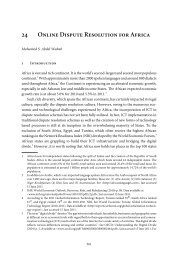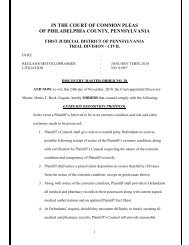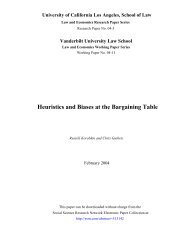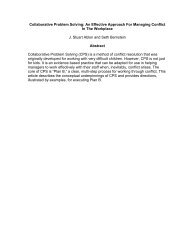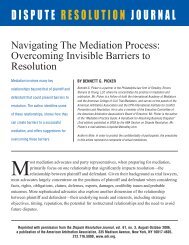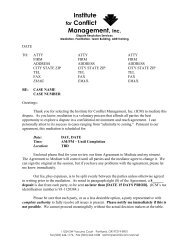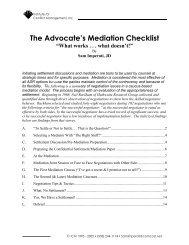17 e-Mediation - Mediate.com
17 e-Mediation - Mediate.com
17 e-Mediation - Mediate.com
You also want an ePaper? Increase the reach of your titles
YUMPU automatically turns print PDFs into web optimized ePapers that Google loves.
Noam Ebner<br />
grid? These two issues are certainly not identical, but they are intertwined at the practical<br />
level, and the few research findings at our disposal have implications for both of them.<br />
To approach these issues, we should first note a couple of <strong>com</strong>ments related to the<br />
evolution of ODR and e-mediation. ODR was developed with an eye towards high-volume<br />
cases sourcing from e-<strong>com</strong>merce settings. These initial settings certainly lend themselves<br />
towards the boilerplating of disputes noted by Bush and Folger as a hallmark of the problemsolving<br />
approach, and may have had some effect on the way ODR terminology developed,<br />
and on the way its technology emerged.<br />
As we have seen, e-mediation has oriented itself around text-based, primarily asynchronous<br />
platforms and processes. This might stem from practicalities or issues of <strong>com</strong>fort,<br />
however we must remember that the medium is never neutral; <strong>com</strong>municating through<br />
any medium has implications for how messages are transmitted, and how they are received. 49<br />
This cannot help but affect the substance of a process.<br />
Research suggests that the use of asynchronous text-based media leads to more taskoriented<br />
and depersonalized <strong>com</strong>munication styles than in face-to-face interactions. 50 This<br />
connects to the research indicating that people have (at least) two distinct informationprocessing<br />
modes: an analytical-rational mode and an intuitive-experiential mode. The<br />
former type of people tends to rely more heavily on logic and deductive thinking and their<br />
associated tactics (e.g., development of positions and limits, use of logical argumentation,<br />
and the presentation of facts). People who adopt an intuitive-experiential mode rely more<br />
heavily on intuition and experience and their associated tactics (e.g., appeals to emotion,<br />
the presentation of concrete personal stories, and the use of metaphors). 51 Asynchronous,<br />
text-based <strong>com</strong>munication does not lend itself equally to these contrasting informationprocessing<br />
styles. Not only does this create a somewhat uneven playing field, favoring<br />
individuals who tend towards analytical-rational expression, it leads the conversational<br />
dynamics into expression of positions, arguments and facts.<br />
The implications of this for e-mediation might be that, left to its own devices, a conversation<br />
aimed at discussing a dispute conducted though asynchronous, text-based media might<br />
easily tend towards a problem-solving orientation, frame a narrowly defined problem to<br />
be solved, and be addressed by parties and mediator with an evaluative approach.<br />
49 N. Ebner, “Negotiating via E-Mail”, in M. Benoliel (ed.), Negotiation Excellence: Successful Deal Making,<br />
World Scientific Publishing, Singapore, 2011.<br />
50 N.J. Kemp and D.R. Rutter, “Duelessness and the Content and Style of Conversation”, British Journal of<br />
Social Psychology (1982) 21.<br />
51 M.J. Gelfand and N. Dyer, “A Cultural Perspective on Negotiation: Progress, Pitfalls, and Prospects,” Applied<br />
Psychology: An International Review (2000) 49, 1.<br />
384



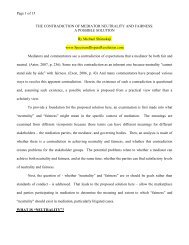
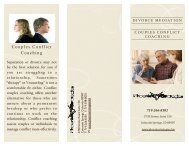
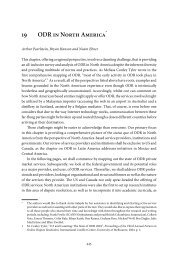
![Settlement Agreement Form [Agreement] - Mediate.com](https://img.yumpu.com/50682143/1/190x245/settlement-agreement-form-agreement-mediatecom.jpg?quality=85)

